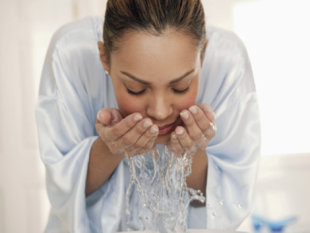
1. Splash with care:
Here's the cold, hard truth: Rinsing your face with icy water won't tighten your pores. And using hot water, though it may feel good, can dehydrate skin. Lukewarm is best, and if you have redness, try cool - not cold - water, to help constrict blood vessels, Waldorf says. What can impact your skin is hard water (check your supply with a simple water-testing strip, available at the hardware store). "Over time, it can cause skin irritation," Baumann says. "Putting a purifier on your bathroom sink will filter out some of those harsh minerals."
2. Figure out your skin type:
"I've found that the majority of women guess their skin type incorrectly, which means they could be using the wrong cleanser," says Leslie Baumann, M.D., a dermatologist and founder of the Cosmetic Medicine and Research Institute at University of Miami. Baumann stresses that it's best to let a dermatologist diagnose your skin type, but she says you can get a good read from this D.I.Y. test: Rinse your clean face with 10 splashes of lukewarm water, then pat it dry and wait 45 minutes. If your face feels tight or looks ashy, you probably have dry skin. If it's shiny all over, it's oily. If just your forehead, nose, and chin - the T-zone - are shiny, you likely have combination skin. And if your skin is easily irritated, that usually means it's sensitive.
3. Use the right cleanser:
"The drier your skin, the fewer skin-stripping suds you want while cleansing," says Heidi Waldorf, M.D., director of laser and cosmetic dermatology at Mount Sinai Medical Center in New York City. And - bargain alert! - drugstore cleansers are just as good as pricier options. "Any fancy ingredients may wash right off your skin anyway," she says. Non-foaming formulas (creams, milks, lotions, oils, and cold creams) are best for dry or combination skin because they have few surfactants, i.e., the stuff that lathers. For sensitive skin, "look for soothing ingredients such as soy, feverfew, or green tea," says Baumann.
4. Stash wipes:
For nights when you're too exhausted to wash your face, keep a box of pre-moistened face wipes in your bedside table. "They clean almost as well as a regular cleanser," Waldorf says.
5. You can skip
Washing your face every morning. So long as you cleanse before bed, "you can nix it the next morning every now and then," says Baumann. (But if you have breakouts, wash twice a day.) Using a separate makeup remover. "Your cleanser or face wipe will take off everything," says Waldorf. The exception: heavy or waterproof eye makeup, which you should dissolve first with an oil-based makeup remover.
The nubby washcloth. "It's too abrasive for most skin types," says Waldorf. Instead, exfoliate two to three times a week with either an electric face brush (ideal for sensitive skin) or a scrub with beads (granules can scratch skin).
No comments:
Post a Comment